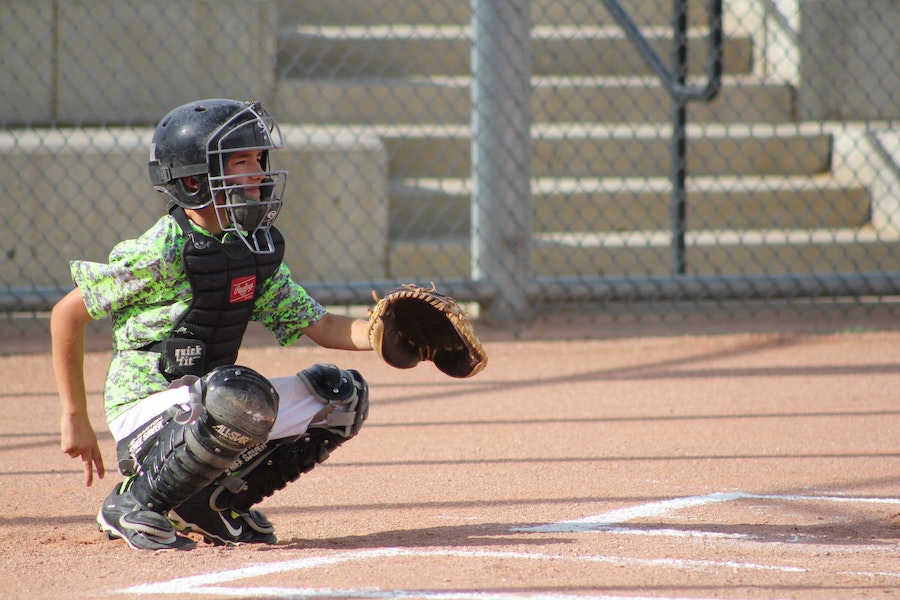Baseball signals are non-verbal cues players and coaches use to communicate instructions and strategies during a game.

They are a fundamental game component, allowing players and coaches to convey information without alerting opponents.
These non-verbal cues serve as a secret language on the field, enabling teams to coordinate their actions and execute complex strategies seamlessly.
This blog post explores and explains all you need about baseball signals.
Let’s dive in!
Understanding Baseball Signals
The basic concept of baseball signals revolves around discreetly relaying instructions to players during every game.
Signals can take various forms, including hand gestures, verbal cues, and indicator signs. Hand signals, such as the steal or bunt sign, are widely used to communicate specific plays.
Therefore, mastering baseball signals requires clear communication, synchronization, and understanding among teammates.
It empowers players to adjust their positions, anticipate plays, and execute coordinated moves effectively.
This strategic communication tool greatly enhances teamwork, contributing to the overall success of a baseball team.
Importance of Signals in Communication in Baseball
Signals play an important role in facilitating effective communication between players and coaches in baseball. Here are the key roles of signals in this context:
Strategy and Instruction
Signals allow coaches to discreetly convey specific strategies, tactics, and instructions to their players. These instructions can include defensive alignments, pitch selection, play calls, and base running strategies.
By using signals, coaches can communicate complex game plans without revealing their intentions to the opposing team.
Coordination and Synchronization
Baseball is a team sport that requires precise coordination among players. Signals enable players to synchronize their actions, positioning, and movements on the field.
They help ensure everyone is on the same page and ready to execute the planned play or strategy.
Real-Time Adjustments
During a game, coaches must make quick decisions and adjustments based on the evolving game situation.
Signals allow coaches to communicate these changes promptly to players, whether it’s a defensive shift, a pitching change, or a new play call.
This ensures that the team can adapt to the circumstances efficiently.
Stealth and Secrecy
By using signals, teams can maintain secrecy regarding their plans, preventing the opposing team from anticipating their actions.
It adds an element of surprise and strategic advantage, making it more challenging for opponents to counteract the team’s strategies effectively.
Easy Communication
In a noisy and crowded baseball environment, verbal communication can be challenging.
Signals provide a non-verbal means of communication that players can easily understand, even in loud stadiums or when they are far apart.
It enhances communication efficiency and reduces the chances of miscommunication.
Player Safety and Injury Prevention
Coaches can use signals to communicate important information about player safety and injury prevention.
For example, a coach may use a specific signal to indicate that a player should slide instead of attempting a standing tag at a base, reducing the risk of collisions and potential injuries.
Signals can also alert players to potential hazards on the field, such as an outfielder calling off an infielder to avoid a collision while attempting to catch a fly ball.

20 Common Types of Baseball Signs
In the world of baseball, communication is key to having successful plays and wins. Here are some of the primary ways players and coaches communicate during a baseball game
Standard – Belt Swipe
The standard steal, often known as a “belt swipe,” is the most common type. The coach or catcher makes the belt swipe sign, placing one hand on their belt or waistband and swiping it across.
Although the meaning can vary depending on the team’s specific signals and strategies, it is commonly used to indicate that the runner should attempt a steal or take an extra base.
It involves the baserunner initiating the steal as soon as the pitcher is trying to deliver the ball. The runner takes off from the current base and attempts to reach the next base before the catcher can make a successful throw.
Delayed – Double Belt Swipe
The delayed steal, commonly called a “double belt swipe,” is a more advanced move meant to surprise the defenders.
When the pitcher throws the ball, the baserunner, in this instance, acts as if they are not trying to steal, but they swiftly shift their behavior and attempt to do so. For this, the belt is double-swiped subtly.
Sacrifice Bunt – Bill of Hat
A sacrifice bunt, represented by the “bill of hat” sign, is performed when a batter intentionally bunts the ball to advance the baserunners while sacrificing their own opportunity to get on base.
The batter occasionally purposely bounces the ball gently toward the infield to move one or more baserunners to a better scoring position. The goal is to advance the runners at the expense of an out.
Suicide Bunt – Neck
A suicide bunt, indicated by the “neck” sign, is a riskier maneuver where the batter bunts the ball aggressively, often with a high chance of getting out, but to advance the baserunner from first to second base or score a runner from third base.
Slash Bunt – Forehead
The slash bunt, symbolized by the “forehead” sign, combines a regular swing and a bunt.
The batter squares to bunt initially but then quickly pulls the bat back and attempts to hit the ball with more force, aiming for a line drive to a specific location on the field.
But for Hit (push or drag) – Chin
The bunt for a hit, represented by the “chin” sign, occurs when the batter attempts to bunt the ball softly and place it in a location where the defense has difficulty making a play.
This technique is commonly used when the batter wants to reach base safely.
Fake Bunt
The fake bunt, indicated by the “ear” sign, involves the batter initially showing a bunt stance but then pulling the bat back without attempting to make contact.
The purpose is to deceive the defense, making them believe a bunt is coming and potentially creating more favorable hitting conditions.
Bunt & Steal
The bunt and steal, represented by the “top of a hat” sign, combines a bunt with a baserunner attempting to steal a base.
The batter lays down a bunt while the baserunner takes off from their current base, aiming to advance to the next base while the defense is focused on the bunt play.
Take
In baseball, the coach or manager gives the “take” sign to the batter, indicating that they should not swing at the pitch. The closed fist is a common gesture used to convey this instruction.
When a batter receives the “take” sign, they are expected to keep the bat on their shoulder and let the pitch pass without attempting to make contact.
This sign is often used in specific situations or when the pitcher is struggling with their control, and the batter needs to be selective and wait for a more favorable pitch to swing at.
High Fastball
The catcher will give a thumb-up sign to signal a high fastball. This indicates to the pitcher that they should throw a fastball at chest level or higher.
As the pitch is thrown, the catcher should come up into a slightly crouched but standing position to receive the pitch.
Fastball
The catcher will put down an odd number of fingers, typically 1 or 3, to signal a fastball. This sign indicates to the pitcher that they should throw a fastball, which is a pitch with high velocity and minimal movement.
Change-up/Curve
The catcher will put down an even number of fingers, usually 2 or 4, to indicate a change-up or curveball. These off-speed pitches have a slower velocity and more movement than a fastball.
The specific finger arrangement may vary depending on the team’s predetermined signs.

Pitchout
When the defensive team anticipates that the baserunner may attempt a steal, the catcher will display a fist as a signal for a pitchout.
A pitchout is intentionally thrown outside the strike zone and away from the batter to make it easier for the catcher to throw out the baserunner attempting to steal a base.
Pickoffs
When a pickoff move is on, meaning the pitcher wants to attempt to catch a baserunner off the base, the coach will give a signal followed by an open hand at the chest (five fingers).
The subsequent action or signal will determine which base the pitcher should throw to.
Pitcher to Bases
The coach will follow the open hand signal with the base number (1, 2, or 3) to indicate to the pitcher which base they should throw to pick off the baserunner.
For example, if the coach gives an open hand followed by the number 2, the pitcher should attempt a pickoff throw to second base.
Catcher’s Snap Throw to a Base
When the catcher wants to make a quick throw to a base to catch a baserunner off guard, the coach will give the open hand signal followed by the number 4 for the lead runner or 5 for the trailing runner.
The infield coach will also provide an indicator to the infielders (1B or 3B) to alert them that they need to cover the respective base.
Repeat Signs
If there is any confusion or the signs need to be repeated, the catcher will pat the top of their head with their hand to indicate to the coach that the signs need to be repeated.
This allows the coach to resend the signs to ensure clear communication between the coaching staff and the players.
Location
In baseball, the location refers to where the pitcher intends to throw the pitch, specifically whether it will be inside the strike zone (inside) or outside the strike zone.
The coach uses the location signs to communicate the desired pitch location to the catcher and pitcher. Here are the common signs for location:
Inside
The coach will wiggle either ear to signal that the pitch should be thrown inside the strike zone. This sign indicates to the pitcher that they should aim the pitch toward the inner portion of the plate, closer to the batter.
Outside
If the coach does not indicate location by default, the pitch should be thrown outside the strike zone. This suggests that the pitcher should aim the pitch toward the outer portion of the plate, away from the batter.
Takeaway
Understanding and effectively utilizing baseball signals is a crucial aspect of the game.
These intricate and strategic gestures communicate between players and coaches, helping coordinate plays, execute strategies, and maintain a competitive advantage.
By studying and mastering these signals, players and coaches can elevate their game and enhance their chances of victory.
So, next time you step onto the field, pay attention to the signals around you and embrace the power of nonverbal communication in the exciting world of baseball.

I was working as a mountain guide, probably all around the planet. One day, I met my wife in the mountains, literally on top of the world. Now, I have a beautiful family and three kids, so I don’t have much time for climbing, but sometimes I go camping with my friends. I am also into gym workouts, and I can’t imagine my life without sports.
Since I ended my professional career as a climbing guide, I’ve been giving personal classes and helping amateurs to get ready for conquering their first peaks. Also, that’s how the whole blog idea appeared.





